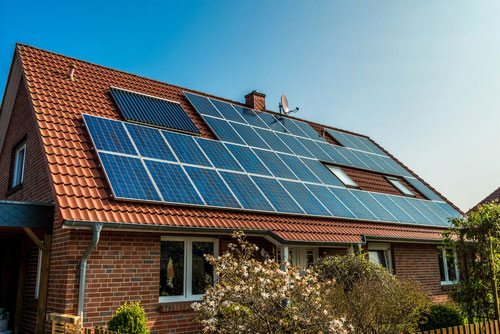The Growing Popularity of Solar Battery Storage Options
With the rising costs of energy, the popularity of solar battery storage options is rapidly increasing. This technology allows homeowners to store energy generated by their solar panels during the day and use it at night when electricity prices are higher.
Solar battery storage systems are an affordable, clean energy option. They allow homeowners to reduce their reliance on the grid and store excess energy that is not used during the day. By installing a solar battery storage system, homeowners can benefit from lower electricity bills and lower carbon emissions.
Solar battery storage options come in a variety of shapes and sizes, allowing homeowners to find the one that best fits their needs. Systems range from small stationary models to large mobile ones. Depending on how much energy a household needs, the size and type of system they choose can affect the price.
The technology is also becoming increasingly user-friendly. Many systems now come with easy-to-use apps that allow homeowners to monitor and manage their energy usage. These apps can alert homeowners if their system needs maintenance or if their energy production is low.
Solar battery storage is becoming an attractive option for many households. With its ease of installation, user-friendly systems, and cost-saving capabilities, this technology is proving to be a powerful tool for reducing energy bills. As more households turn to solar battery storage, the popularity of this energy option is sure to continue to grow.
How Automation and AI are Driving Solar Innovation
As solar energy continues to become increasingly popular as an alternative energy source, automation and artificial intelligence (AI) are driving solar innovation in new and exciting ways. Automation and AI are making solar technology increasingly affordable, efficient, and accessible to a wide range of customers.
One key way automation and AI are driving solar innovation is by improving the accuracy and speed of solar panel installation. Automated installation processes now allow for precise panel placement, which ensures that the most efficient and cost-effective placement of solar panels is achieved. Furthermore, automated systems can detect minute variations in panel orientation and adjust accordingly, resulting in optimal efficiency and greater energy production.
In addition, automation and AI are helping to make solar energy more affordable. Automated processes have made it possible to reduce labor costs associated with the installation and maintenance of solar panels. Furthermore, AI-driven smart systems are helping to identify and address problems in solar power plants, resulting in fewer costly repairs and maintenance.
Finally, automation and AI are making solar energy more accessible to a wider range of customers. Automated systems are helping to make the installation and maintenance of solar panels easier and more cost-effective, allowing customers with limited budgets to take advantage of the benefits of solar energy. Furthermore, AI-driven systems are helping to identify the best locations for solar panel installation, making it easier for customers across a variety of climates and geographical locations to make the most of solar energy.
Automation and AI are revolutionizing the solar energy industry, making solar energy more affordable, efficient, and accessible. As the technology advances, the benefits of solar energy will become increasingly available to a wider range of customers, helping to move the world towards a more sustainable future.
Exploring the Benefits of Solar Tracking Solutions
The world is quickly transitioning to renewable energy sources, and the need for efficient and effective solar energy solutions has never been greater. Solar tracking solutions are emerging as a viable option for businesses and homeowners looking to benefit from the power of the sun.
Solar tracking solutions are systems designed to increase the efficiency of solar panels. The systems use sophisticated technology to adjust the angle of the solar panel based on the position of the sun in the sky. This ensures that the solar panel is angled to receive maximum sunlight throughout the day, thus increasing the amount of energy generated. This can significantly improve the efficiency of solar energy systems.
In addition to increased energy efficiency, solar tracking solutions can generate substantial cost savings for businesses and homeowners. By increasing the efficiency of their solar energy systems, businesses and homeowners can reduce their energy costs. Moreover, solar tracking systems can help reduce the cost of installation for solar energy systems. As the systems are designed to adjust to the sun’s position, they require fewer panels than traditional solar energy systems. This can help reduce the overall cost of installation.
Finally, solar tracking solutions can help reduce maintenance costs. As the systems require less maintenance, businesses and homeowners can save on repair and maintenance costs. Moreover, solar tracking systems can be designed to be robust and resistant to the elements, further reducing maintenance costs.
In conclusion, solar tracking solutions are an effective and efficient way to take advantage of the power of the sun. The systems offer increased energy efficiency, cost savings, and reduced maintenance costs. As such, they are an attractive option for businesses and homeowners looking to benefit from solar energy.
Advances in Solar Panel Efficiency and Durability
Advances in solar panel technology have enabled homeowners and businesses to reap the benefits of clean, renewable energy while reducing their reliance on traditional power sources. Recent advances in solar panel efficiency and durability have made solar energy a cost-effective and reliable source of energy.
One of the key advances in solar panel efficiency has been the development of multi-junction solar cells. Multi-junction cells are composed of multiple layers of semiconductors, each layer optimized to absorb different wavelengths of light. By combining these layers, multi-junction cells can absorb more of the sun’s energy, leading to greater efficiency and energy output.
In addition to improving efficiency, advances in solar panel durability have enabled solar panels to withstand harsh weather conditions and extended exposure to the elements. Solar panels are now manufactured using tougher, more durable materials, such as tempered glass and polycrystalline silicon. These materials are less prone to cracking and other damage, allowing solar panels to remain operational for longer periods of time.
The combination of increased efficiency and durability has made solar energy a viable and cost-effective option for many homeowners and businesses. As the technology continues to advance, solar energy may become a viable option for even more people.
Understanding the Impact of Solar Energy on the Environment
The effects of solar energy on the environment are varied and far-reaching. As one of the most abundant sources of renewable energy, its use has become increasingly widespread in recent years, and with it, the potential to make a positive environmental impact.
The first significant environmental benefit of solar energy is the reduction in greenhouse gas emissions. Solar panels require no combustion to generate electricity, meaning they have no carbon dioxide or other pollutants in their production. This makes them an attractive alternative to traditional carbon-intensive sources of energy, such as coal and natural gas. As the deployment of solar energy increases, it will contribute to reducing the amount of carbon dioxide in the atmosphere, helping to slow global climate change.
Solar energy is also beneficial in that it can provide electricity without the use of any water. This is significant, as water is a finite resource, and many traditional sources of energy, such as coal and nuclear power, require large amounts of water in their production, which can place strains on local ecosystems. By harnessing solar energy, electricity can be generated without the need for water, freeing up this precious resource for other uses.
The use of solar energy also helps to reduce the impact of energy production on local land. Solar panels require relatively little space compared to traditional energy sources such as coal, natural gas and nuclear power plants, meaning that more land can be preserved for other uses. In addition, the land on which solar panels are installed can still be used for other purposes, such as farming or ranching, which can help to support local communities and economies.
Finally, the use of solar energy helps to reduce the environmental hazards associated with traditional energy sources. Solar energy is clean and does not produce any hazardous byproducts, such as nuclear waste or air pollutants. This makes it a much safer option for communities located near power plants or other sources of traditional energy.
In summary, the use of solar energy is beneficial for the environment in a number of ways. By reducing greenhouse gas emissions, minimizing water use, preserving land for other uses, and reducing the risks associated with traditional energy sources, it is an attractive and increasingly popular option for those looking to reduce their environmental impact.






